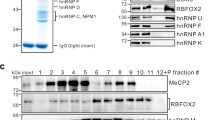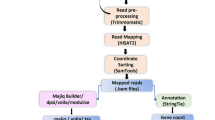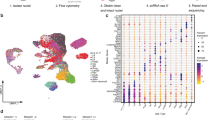Abstract
Among cases in the Australian Rett Syndrome Database, the nonsense mutation p.R270X is one of the most commonly occurring single pathogenic MECP2 mutations. In two recent published reports of the MECP2 mutational spectrum the p.R270X appeared to be under represented. We hypothesised that increased mortality arising from this mutation may underlie this apparent discrepancy. We investigated our hypothesis in two independent study groups from Australia and the UK with prospective data collections (total n=524). Only females with Rett syndrome and an identified MECP2 mutation were included. Significant differences in survival were detected among Rett syndrome cases grouped for the eight most frequent mutations (log-rank χ2 (7)=15.71, P=0.03). Moreover, survival among cases with p.R270X, when compared with survival among cases with all the other mutations was reduced (log-rank χ2 (2)=6.94, P=0.01). Our observation of a reduced survival associated with the p.R270X mutation offers an explanation for the under representation of p.R270X in older subjects with Rett syndrome.
Similar content being viewed by others
Log in or create a free account to read this content
Gain free access to this article, as well as selected content from this journal and more on nature.com
or
References
Hagberg B, Aicardi J, Dias K, Ramos O : A progressive syndrome of autism, dementia, ataxia, and loss of purposeful hand use in girls: Rett's syndrome: report of 35 cases. Ann Neurol 1983; 14: 471–479.
Amir RE, Van den Veyver IB, Wan M, Tran CQ, Francke U, Zoghbi HY : Rett syndrome is caused by mutations in X-linked MECP2, encoding methyl- CpG-binding protein 2. Nat Genet 1999; 23: 185–188.
Renieri A, Meloni I, Longo I et al: Rett syndrome: the complex nature of a monogenic disease. J Mol Med 2003; 81: 346–354.
Colvin L, Leonard H, de Klerk N et al: Refining the phenotype of common mutations in Rett syndrome. J Med Genet 2004; 41: 25–30.
Dragich J, Houwink-Manville I, Schanen C : Rett syndrome: a surprising result of mutation in MECP2. Hum Mol Genet 2000; 9: 2365–2375.
Christodoulou J : RettBASE: The IRSA MECP2 variation database; Sydney, Western Sydney Genetics Program, Wiley-Liss, Inc. http://mecp2.chw.edu.au/mecp2/,accessed 18 April 2005.
Schanen C, Houwink EJ, Dorrani N et al: Phenotypic manifestations of MECP2 mutations in classical and atypical Rett syndrome. Am J Med Genet 2004; 126A: 129–140.
Smeets E, Schollen E, Moog U et al: Rett syndrome in adolescent and adult females: clinical and molecular genetic findings. Am J Med Genet 2003; 122A: 227–233.
Kerr AM, Prescott RJ : Predictive value of the early clinical signs in Rett disorder. Brain Dev 2005, in press.
Colvin L, Fyfe S, Leonard S et al: Describing the phenotype in Rett syndrome using a population database. Arch Dis Child 2003; 88: 38–43.
Australian Institute of Health and Welfare. National Death Index (deaths from 1980 to present), AIHW: http://www.aihw.gov.au/cancer/ndi/index.cfm,accessed 18 April 2005.
Leonard H, Bower C, English D : The prevalence and incidence of Rett syndrome in Australia. Eur Child Adolesc Psychiatr 1997; 6: 8–10.
del Junco D, Nancy MN, Steve W et al: Survival in a large Cohort of US girls and Women with Rett Syndrome. J Child Neurol 1993; 8: 101–102.
Kerr AM, Armstrong DD, Prescott RJ, Doyle D, Kearney DL : Rett syndrome: analysis of deaths in the British survey. Eur Child Adolesc Psychiatr 1997; 6 (Suppl 1): 71–74.
Hagberg B, Berg M, Steffenburg U : Three decades of sociomedical experiences from West Swedish Rett females 4–60 years of age. Brain Dev 2001; 23 (Suppl 1): S28–S31.
Huppke P, Held M, Handefeld F, Engel W, Laccone F : Influence of mutation type and location on phenotype in 123 patients with Rett Syndrome. Neuropediatrics 2002; 33: 63–68.
Hoffbuhr K, Devaney JM, LaFleur B et al: MeCP2 mutations in children with and without the phenotype of Rett syndrome. Neurology 2001; 56: 1486–1495.
Leonard H, Colvin L, Christodoulou J et al: Patients with the R133C mutation: is their phenotype different from patients with Rett syndrome with other mutations? J Med Genet 2003; 40: e52.
Leonard H, Moore H, Carey M et al: Genotype and early development in Rett syndrome: the value of international data. Brain Dev, in press.
Hoffbuhr KC, Moses LM, Jerdonek MA, Naidu S, Hoffman EP : Associations between meCP2 mutations, X-chromosome inactivation, and phenotype. Ment Retard Dev Disabil Res Rev 2002; 8: 99–105.
Moore H, Leonard H, de Klerk N et al: Health Service Use in Rett Syndrome. J Child Neurol 2004; 19: 42–50.
Hunter K : Looking from the inside out: a parent's perspective. Ment Retard Dev Disabil Res Rev 2002; 8: 77–81.
Moore H, Leonard H, Fyfe S, de Klerk N, Leonard N : InterRett – the application of bioinformatics to international Rett syndrome research. Ann Hum Biol 2005; 32: 228–236.
Acknowledgements
We acknowledge the National Institute of Child Health and Human Development for its current funding of the Australian Rett Syndrome Database under NIH Grant number 1 R01 HD43100-01A1 PI and the Financial Markets Foundation for Children and the Rett Syndrome Australian Research Fund for previous funding. HL is funded by NHMRC program Grant 353514. JC is funded by NHMRC project Grants 185202 and 346603. HA is funded by The Health Foundation, AK and MB by the Rett Syndrome Association UK and MB by the Rett Syndrome Research Foundation, the International Rett Syndrome Association, the Rett Syndrome Association Scotland and the Scottish Hospital Endowments Research Trust. We express our gratitude to all the families who have participated in the study; the Australian Paediatric Surveillance Unit and the Rett Syndrome Association of Australia who facilitated case ascertainment in Australia. In addition, we thank the Rett Syndrome Association UK and the regional genetics and paediatrics services, which have all strongly supported Rett syndrome research in the United Kingdom.
Author information
Authors and Affiliations
Corresponding author
Rights and permissions
About this article
Cite this article
Jian, L., Archer, H., Ravine, D. et al. p.R270X MECP2 mutation and mortality in Rett syndrome. Eur J Hum Genet 13, 1235–1238 (2005). https://doi.org/10.1038/sj.ejhg.5201479
Received:
Revised:
Accepted:
Published:
Issue date:
DOI: https://doi.org/10.1038/sj.ejhg.5201479
Keywords
This article is cited by
-
Twenty years of surveillance in Rett syndrome: what does this tell us?
Orphanet Journal of Rare Diseases (2014)
-
Molecular genetics of Rett syndrome: when DNA methylation goes unrecognized
Nature Reviews Genetics (2006)



